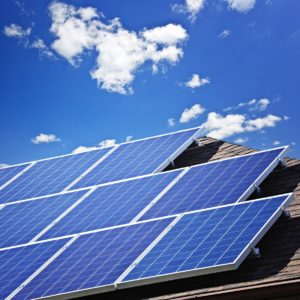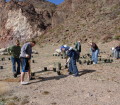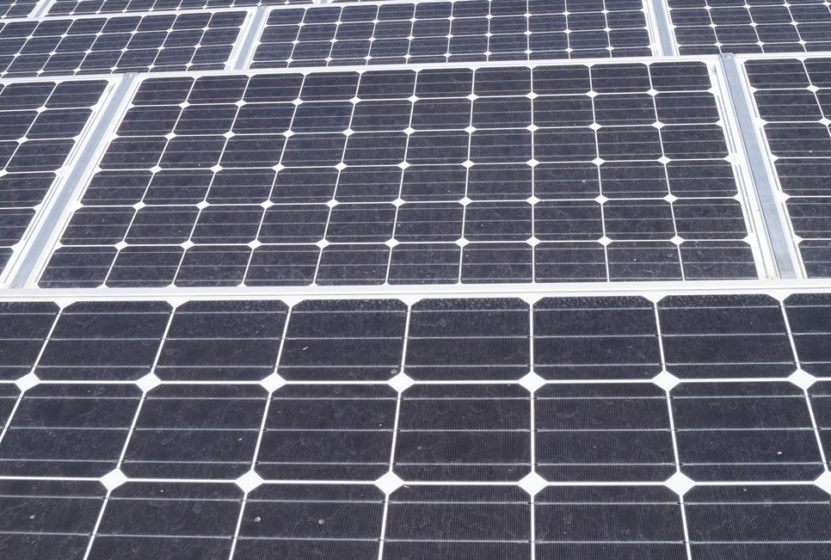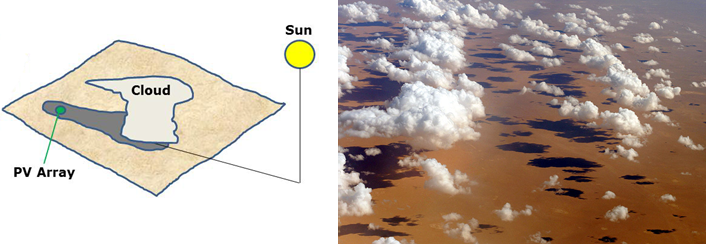Solar Panels in Nevada
–L. Brazfield Photo
Doing the Books on Solar Power in Nevada
NEXUS economists analyze the financial benefits, costs and risks associated with solar energy production
By Jane Palmer
March, 2017
 “Most of us take it for granted that when you flip the switch, electricity is going to be there. Behind that switch are years and years of engineering knowhow, financing, risk taking, and regulatory activities constantly and seamlessly taking place.” says NEXUS economist Dr. Dilek Uz at UNR. “Yes we want more of that renewable energy for multiple reasons. If we want to move from point A to B, we have to make sure that we consider all the options with their costs and benefits. There are many ways to achieve this goal but we want the one that is least costly and most fair.”
“Most of us take it for granted that when you flip the switch, electricity is going to be there. Behind that switch are years and years of engineering knowhow, financing, risk taking, and regulatory activities constantly and seamlessly taking place.” says NEXUS economist Dr. Dilek Uz at UNR. “Yes we want more of that renewable energy for multiple reasons. If we want to move from point A to B, we have to make sure that we consider all the options with their costs and benefits. There are many ways to achieve this goal but we want the one that is least costly and most fair.”A Changing Landscape
 The participation in the net metering program has recently soared which has raised questions regarding its sustainability with the existing rules. Uz is studying the economics of net metering in Nevada and in the U.S. including the decisions that the Public Utilities Commission might have to make. As a result of fast growing adoption of net metering, conflicts have arisen between the various stakeholders: the utility customers, solar PV companies, and the regulated utilities. “So now we are seeing changes in the regulatory landscape that occurred as a response to this tension which will pretty much determine the path that distributed generation will take.” Uz says.
The participation in the net metering program has recently soared which has raised questions regarding its sustainability with the existing rules. Uz is studying the economics of net metering in Nevada and in the U.S. including the decisions that the Public Utilities Commission might have to make. As a result of fast growing adoption of net metering, conflicts have arisen between the various stakeholders: the utility customers, solar PV companies, and the regulated utilities. “So now we are seeing changes in the regulatory landscape that occurred as a response to this tension which will pretty much determine the path that distributed generation will take.” Uz says.Working to Reduce Risk
Left: Satellite Image of Cloud Shadow – Image from “Physically-Based Satellite Methods” by Steven Miller et al., Chapter 3 in “Solar energy forecasting and resource assessment”, book edited by Jan Kleissl)
Right: Shadows cast by clouds over the desert.–Open source
Spreading the Sunshine
 “Economics is like one of those Russian dolls,” Harris says. “Once you start doing things, other things open up. It’s what we call unintended consequences.” For solar power to be not just sustainable, but profitable, in future decades economists have to investigate all the variables and permutations associated with this relatively new industry.
“Economics is like one of those Russian dolls,” Harris says. “Once you start doing things, other things open up. It’s what we call unintended consequences.” For solar power to be not just sustainable, but profitable, in future decades economists have to investigate all the variables and permutations associated with this relatively new industry._______________________________________
Maximizing the Benefits of the Solar Nexus Project
_______________________________________
The Solar Nexus research into solar energy, water and the environment has, and will continue to have, positive economic impacts in Nevada. Research on solar energy efficiency will lead to less expensive and more competitive solar electricity. Economic evaluation of solar projects, and using water and energy as metrics allows Nevada to better allocate its scarce water resources. The project’s commitment to external engagement with stakeholders will enable NEXUS scientists to collaborate locally and nationally while developing relationships with industry and funding agencies. The NEXUS economic team, in ongoing assessments, works to balance all the different goals of the project, with the ultimate mission of supporting economic development in Nevada.
_______________________________________

NEXUS Notes is a monthly publication of the Solar Nexus Project, which is a five-year research project funded by the National Science Foundation’s Experimental Program to Stimulate Competitive Research “EPSCoR” (Cooperative Agreement #IIA-1301726) focusing on the nexus of (or linkage between) solar energy generation and Nevada’s limited water resources and fragile environment.
Any opinions, findings, and conclusions or recommendations expressed in this material are those of the author(s) and do not necessarily reflect the views of the National Science Foundation.
_______________________________________
If you would like to know more about the NEXUS project,
please contact, Dr. Gayle Dana
Gayle.Dana@dri.edu
530-414-3170
_______________________________________









